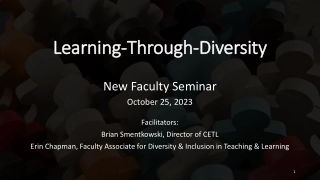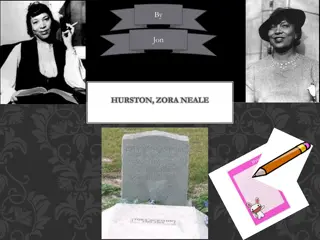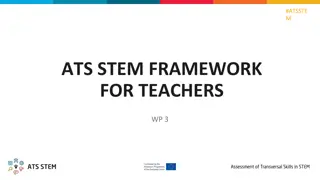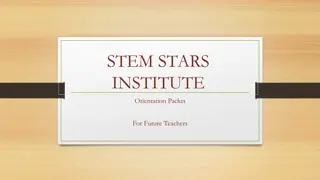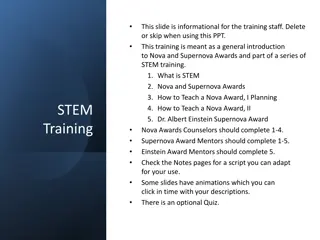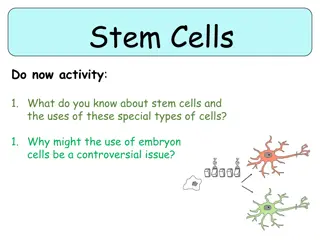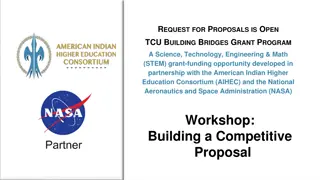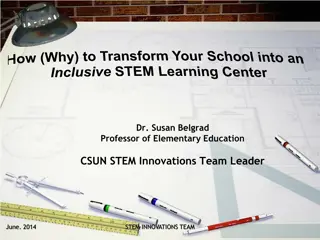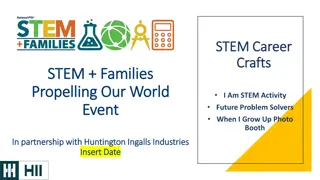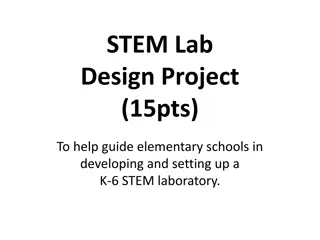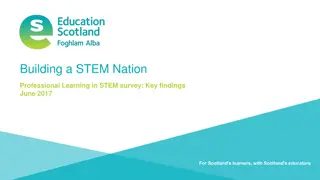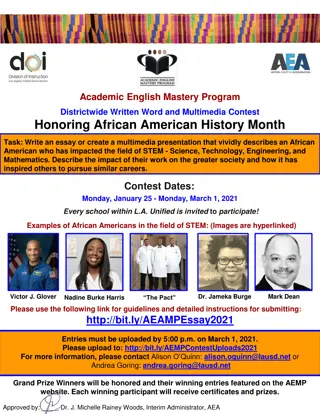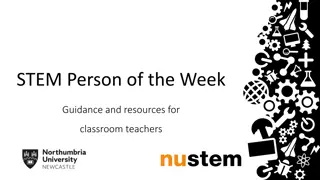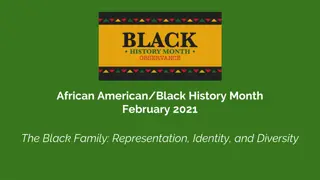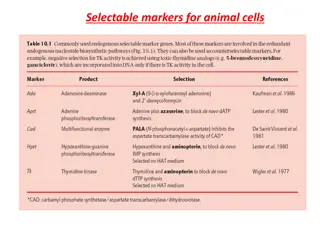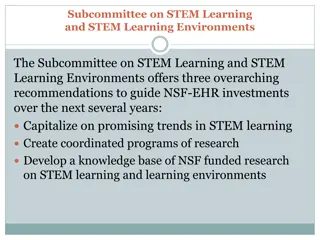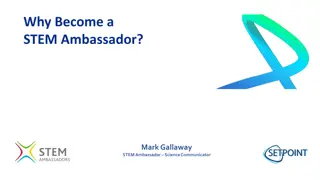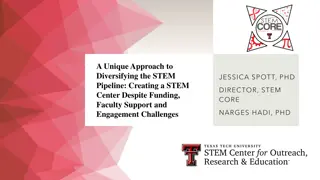Inspiring Black and African American STEM Role Models
Beth Brown, Sarah Richardson, Gladys West, Mae Jemison, and Dorothy Vaughan are exemplary black and African American women who have made significant contributions in STEM fields. From astrophysics to bioengineering, programming to space exploration, these remarkable individuals have broken barriers and paved the way for future generations. Their achievements serve as inspiration and encouragement for aspiring individuals interested in pursuing careers in STEM.
Download Presentation

Please find below an Image/Link to download the presentation.
The content on the website is provided AS IS for your information and personal use only. It may not be sold, licensed, or shared on other websites without obtaining consent from the author. Download presentation by click this link. If you encounter any issues during the download, it is possible that the publisher has removed the file from their server.
E N D
Presentation Transcript
BLACK AND AFRICAN AMERICAN STEM ROLE MODELS
BETH BROWN Brown graduated Summa Cum Laude with a degree in Astrophysics from Howard University in Washington, DC.. She went on to grad school at the University of Michigan, becoming the first African- American female to get an Astronomy PhD there. After graduating, Brown went on to work as an astrophysicist at NASA. She collected data on the environment of elliptical galaxies. Elliptical galaxies are thought to be the result of two smaller galaxies merging, and each is believed to contain a supermassive black hole in its center.
SARAH RICHARDSON Richardson is the CEO and founder of MicroByre, a bioengineering company which seeks to convert non- model species into genetically tractable strains within which the techniques from model organisms can be practiced. Byre means cowshed in Old English, her vision for MicroByre was to be a bacterial barn where bioengineers turn wild microbes into useful chemicals. For example, E. coli has difficulty converting biomass to petrochemicals, a task that Richardson hopes microbes might one day take on. You can t make E. coli betray their nature and eat anything other than sugar, Richardson explains. Biomass such as lignin would be a cheaper, more sustainable feedstock. But if you want a microbe to change what it s producing and change what it s eating, it would require too many genetic edits. The process would fail. That s where Richardson s wild-microbe barn comes in. With a team of chemists, microbiologists, and software engineers, MicroByre aims to find the right bacterium for each job and coax it, with minimal editing, to work in industrial environments.
GLADYS WEST Hired at the Naval Surface Warfare Center in Dahlgren, Virginia in 1956, West worked as a programmer and analyzed satellite data. She was able to use satellite data to put together altimeter models of the Earth s shape with extreme precision. She was then recommended to work as the project manager for the Seasat radar altimetry project, the first satellite that could remotely sense oceans. Through the mid-70s and 80s, Dr. West programmed an IBM computer to provide extremely precise calculations to model the shape of the Earth, a geoid, optimized for what eventually became the Global Positioning System (GPS) orbit.
MAE JEMISON The first African-American woman to fly in space, Mae Jemison (1956-) holds a B.S. in chemical engineering. In 1992, she served on an eight-day Space Shuttle mission that conducted microgravity investigations in materials and life sciences while orbiting Earth 127 times. Jemison was a co- investigator on the bone cell research experiment flown on the mission. She was also the first astronaut to appear on Star Trek.
DOROTHY VAUGHAN Vaughan came to the Langley Memorial Aeronautical Laboratory in 1943, during the height of World War II, leaving her position as the math teacher at Robert Russa Moton High School in Farmville, VA. Vaughan was assigned to the segregated "West Area Computing" unit, an all-black group of female mathematicians, who were originally required to use separate dining and bathroom facilities. She was promoted to lead the group, making her the NACA's first black supervisor, and one of the NACA's few female supervisors. The Section Head title gave Dorothy rare Laboratory-wide visibility, and she collaborated with other well- known (white) computers like Vera Huckel and Sara Bullock on projects such as compiling a handbook for algebraic methods for calculating machines.
CLAUDIA ALEXANDER Alexander is a Geophysicist. After a high school summer internship in the engineering department at NASA s Ames Research Center, Alexander became more interested in earth-science and majored in geophysics at UC-Berkeley. Alexander then worked at NASA s Jet Propulsion Laboratory where she contributed to many different missions and showed her expertise in areas such as studying comets and understanding solar wind. She was the project manager of the Galileo mission, the goal of which was to make the first study of Jupiter and its moons and magnetosphere from orbit. She then was the project scientist of the Rosetta mission, which aimed to make a detailed study of a comet and was the first mission designed to orbit and land on a comet.
KATHERINE JOHNSON Johnson worked at NASA for 33 years before retiring in 1986. She checked the calculations for John Glenn s Friendship 7 orbital mission. She also did the calculations which helped synch Project Apollo s Lunar Module with the lunar- orbiting Command and Service Module. She later worked on the Space Shuttle and the Earth Resources Technology Satellite (ERTS, later renamed Landsat) and authored or coauthored 26 research reports.
SHAUN WASHINGTON Geoscience Analyst at Tudor, Pickering, Holt & Co. He specializes in geospatial analytics/mapping, subsurface data management, G&G applications/software for seismic interpretation, 3D visualization/modeling, well log analysis & GIS in support of geoscientist, petrophysicist, reservoir/prod uction engineers. He also the treasurer for the National Association of Black Geologists.
MARY JACKSON She was NASA s first Black female engineer and co-authored 12 technical papers there. Petitioned to take graduate courses to work on the National Advisory Committee for Aeronautics (NACA) Supersonic Pressure Tunnel. She earned a dual degree in mathematics and physical sciences.
LISA WHITE Paleontologist. White was a professor of geosciences and the associate dean of the College of Science and Engineering at San Francisco State University for 22 years. She taught undergraduate classes in paleontology, historical geology, and oceanography, and guided research projects with graduate students in Miocene diatoms of the Monterey Formation of CA, and fossil cold seep assemblages in the Franciscan Complex. In 2015, White was a featured scientist in, NOVA Making of North America, A three-part series. Currently, she works as Assistant Director at University of California Berkeley Museum of Paleontology. White is also currently Chair of the Diversity and Inclusion Advisory Committee for the American Geophysical Union.
HAKEEM OLUSEYI Oluseyi holds three degrees in physics and one in mathematics. He worked with the 2011 Nobel Prize winning Supernova Cosmology Project, developing detectors for a planned space-based telescope that will investigate the nature of the dark energy that is accelerating the universe's expansion. He is a professor at the Florida Institute of Technology, and a frequent contributor to the Discovery Channel and National Geographic. He has given multiple TED talks and is regularly invited to speak at science forums all around the world. For his science outreach work, he was selected as a 2012 TED Global Fellow. In 2002, through an organization called Cosmos Education, Hakeem began visiting sub-Saharan African schools to inspire young students with science demonstrations. His advice for students interested in science is to find role models and mentors in shows, books, and in person.
ESTELLA ATEKWANA Atekwana is currently the dean of the College of Earth, Ocean and Environment at University of Delaware. She holds a Bachelor's and Master's in Geology from Howard University, as well as a Ph.D. in Geology from Dalhousie University. Her research interests include: Biogeophysics, Near Surface Geophysics, Tectonics, Geodynamics, Continental Rifting, and Structural Geophysics. Atekwana has received a number of honors and awards for excellence in teaching and research, including the 2016 Society of Exploration Geophysicists Outstanding Educator Award, Regents Professor and the 2015 Oklahoma State University Eminent Faculty Award, which is awarded to a faculty member who has made sustained contributions to scholarly creativity, teaching and service, bringing honor and recognition to Oklahoma State University.
RUFUS CATCHINGS Catchings grew up in a racially segregated North Carolina in the late 1950 s and 1960s. He and his siblings were some of the first African American students integrated into previously segregated schools, following the 1964 Civil Rights Act and Brown v. Board of Education legislation. Catchings completed his bachelor s degree in Geology from Appalachian State University, master s degree in Geophysics from the University of Wisconsin- Madison, and Ph.D. in Geophysics from Stanford University. He also did graduate work at the Massachusetts Institute of Technology. His current work includes subsurface research in Beijing, China, Koyna, India, and Vancouver, Canada. Among the accolades for his work, Catchings has been named a Fellow by the Geological Society of America and has been awarded the Department of the Interior Superior Service Award and Unit Award for Excellence of Service, which recognizes significant achievements within natural science. He utilizes techniques called PGV of Guided Waves and Vp/Vs Ratio Mapping to precisely locate and identify faults. The former method locates faults at the surface using sensors to measure energy traveling within fault zones, and the latter method identifies subsurface faults using the ratio of P- to S-wave velocities.
CHRISTINA BARROW Barrow is a medical physicist. She majored in electrical engineering and then worked in server development at Dell Computer Corporation for three years. Afterwards, she went on to accept a position in the biomedical engineering field. At this point, she pursued graduate school in Medical Physics, a combination of modern medicine, math, and physics. Barrow is currently working on a clinical trial project in radiation oncology. If successful, this project will allow VA medical personnel to treat patients using a variety of radiation research protocols and provide them with access to the latest techniques in patient care.
SHIRLEY ANN JACKSON Jackson is a theorhetical physicist and was the first African American woman to earn a PhD from MIT. During her undergraduate work, she was left in social isolation because she was getting an education during a time of heavy discrimination. However, she continued to pursue her education and was determined to build her knowledge in science during these challenging times. Jackson is the 18th president of Rensselaer Polytechnic Institute, the oldest technological research university in the United States, where she has led an extraordinary transformation since 1999. She has been appointed by former presidents Clinton and Obama, for separate positions in the government dedicated to expanding STEM education.
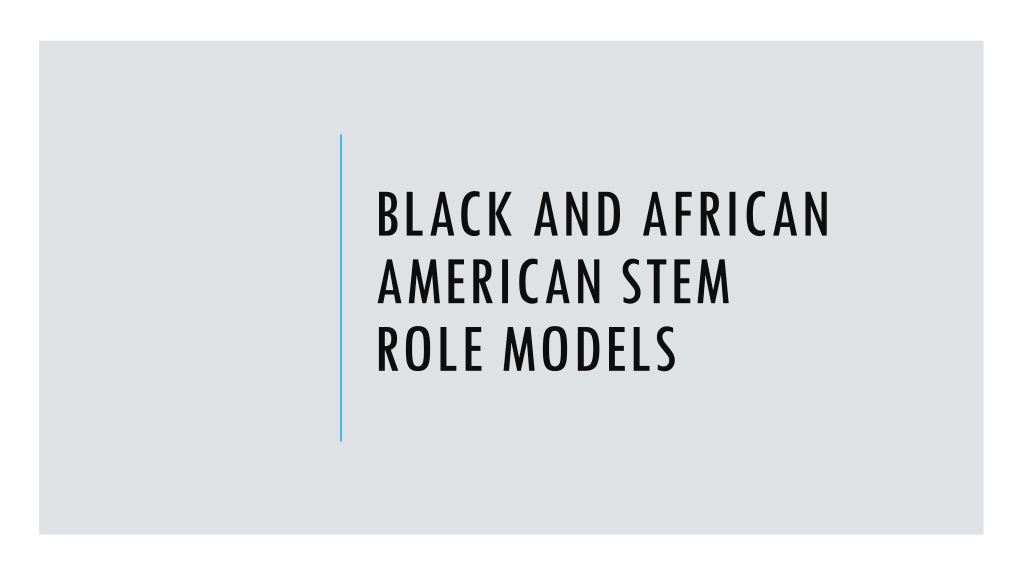
 undefined
undefined






